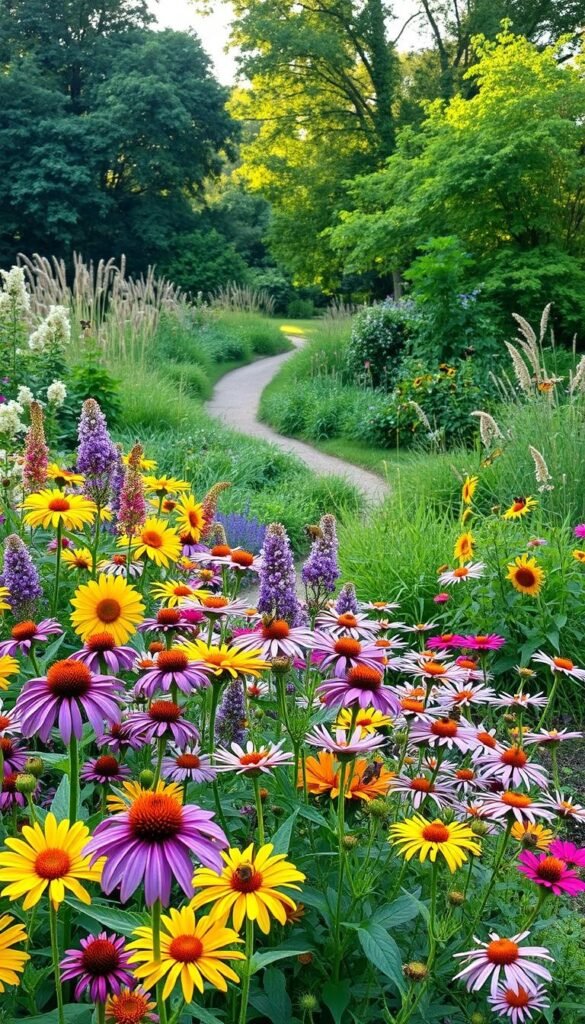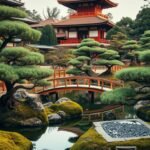Your outdoor area holds untapped potential to become a buzzing sanctuary for bees, butterflies, and other vital creatures. The U.S. Fish and Wildlife Service confirms that even small spaces like balconies or patio containers can fuel environmental change. Imagine sipping coffee while watching hummingbirds dart between blooms you nurtured.
Pollinators drive healthy ecosystems, yet their populations face steep declines. By designing thoughtful plant arrangements, you’ll provide food sources and safe havens these species need to thrive. It’s not about perfection – it’s about offering consistent support through every season.
This guide simplifies transforming any yard or urban space into a wildlife refuge. You’ll learn to choose native flowers that bloom successively, create sheltered zones, and avoid harmful chemicals. Whether you’re working with raised beds or sprawling lawns, practical solutions await.
Beyond helping butterflies, your efforts strengthen local food systems and biodiversity. Ready to swap basic landscaping for a vibrant habitat? Let’s explore how thoughtful gardening choices create ripple effects far beyond your property line.
Understanding the Importance of Pollinator Gardens
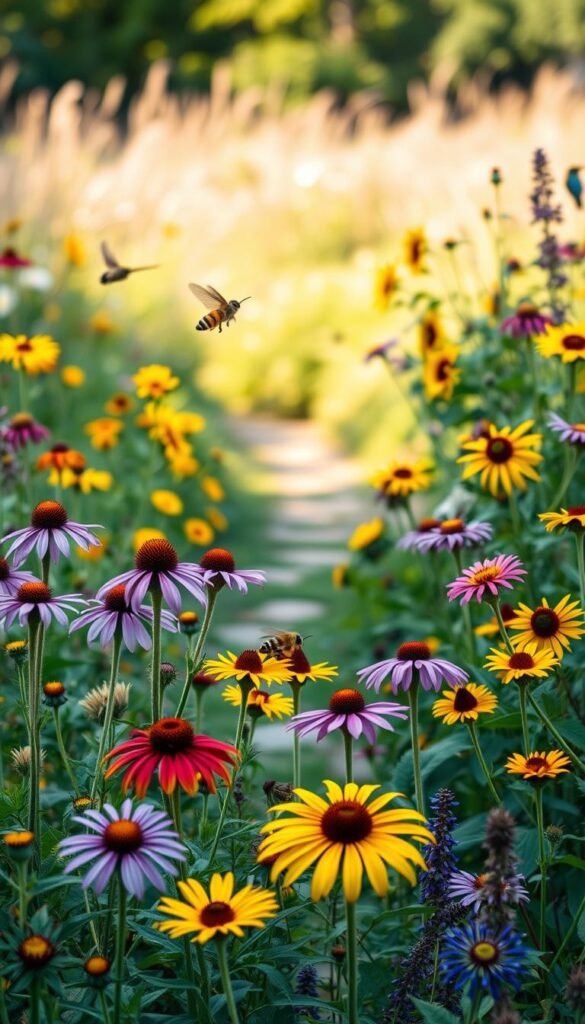
Beneath the flutter of wings and hum of activity lies nature’s most vital partnership. Pollinators like bees and butterflies act as eco-system engineers, transferring pollen between plants to help them reproduce. Without their work, over 75% of flowering plants and 35% of global food crops would vanish, according to the U.S. Fish & Wildlife Service.
Nature’s Essential Workforce
These tiny workers don’t just support wildflowers – they’re the backbone of your favorite foods. Apples, almonds, and even coffee rely on pollinators. By planting diverse species, you’ll help sustain both wild ecosystems and agricultural systems.
Why Local Plants Matter Most
Native plants share an evolutionary history with regional pollinators, offering perfect nutrition and shelter. Monarch butterflies, for example, only lay eggs on milkweed. Choosing local flora creates a familiar buffet for wildlife while reducing water use. Experts at Gardening Rise note that native gardens need 50% less maintenance than traditional landscapes.
Your garden becomes a life raft in urban areas where natural habitats disappear. Even a few square feet of native blooms can feed hundreds of pollinators daily. Remember – every flower counts when rebuilding these critical connections.
Planning Your Garden Layout and Site Selection
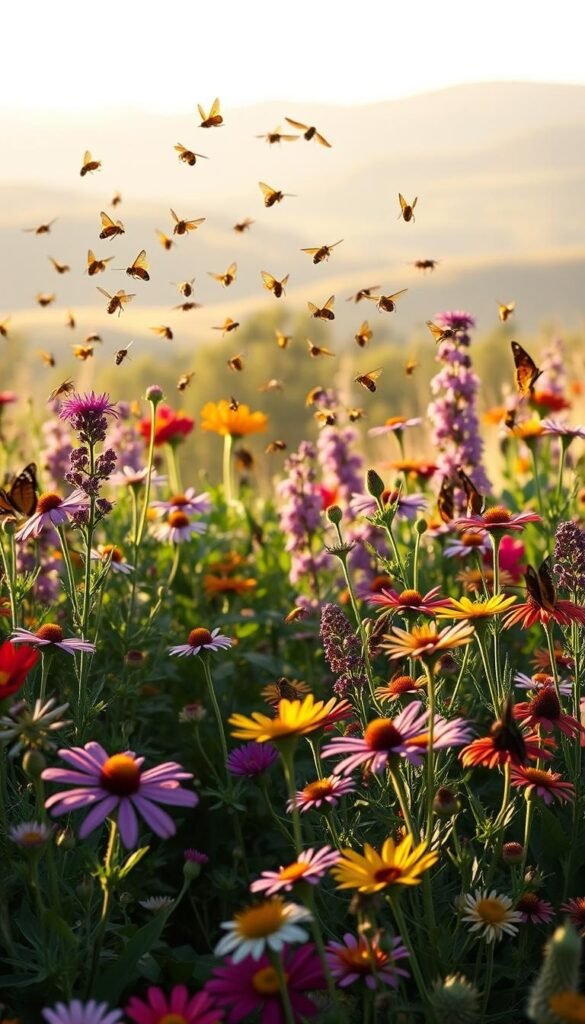
Designing a habitat for pollinators begins with smart site selection. Your yard’s unique features – from sunlight patterns to soil composition – determine which plants will thrive. Start by observing your space at different times to track how shadows move.
Assessing Sunlight, Soil, and Space in Your Yard
Most nectar-rich blooms need 6+ hours of direct sun daily. Use a free app like Sun Seeker to map light exposure. Test your soil’s texture with this simple method:
| Soil Type | Identification | Best Plants |
|---|---|---|
| Sandy | Gritty, drains quickly | Purple coneflower, butterfly weed |
| Clay | Sticky when wet | Swamp milkweed, Joe-Pye weed |
| Loamy | Crumbly texture | Black-eyed Susan, bee balm |
Note areas with natural windbreaks like fences or shrubs. These spots make ideal butterfly cafés – sheltered zones where insects can feed undisturbed.
Choosing the Best Location for Maximum Pollinator Visits
Prioritize spaces near water sources like birdbaths or child-friendly puddling stations. South-facing slopes warm faster, attracting early-season visitors. Leave some bare ground for ground-nesting bees.
Vertical space matters too! Train climbing vines like passionflower on trellises. This approach works wonders in small yards – even balcony gardens can host 15+ pollinator species with proper planning.
Creating a Pollinator-Friendly Garden Design to Attract Bees and Butterflies
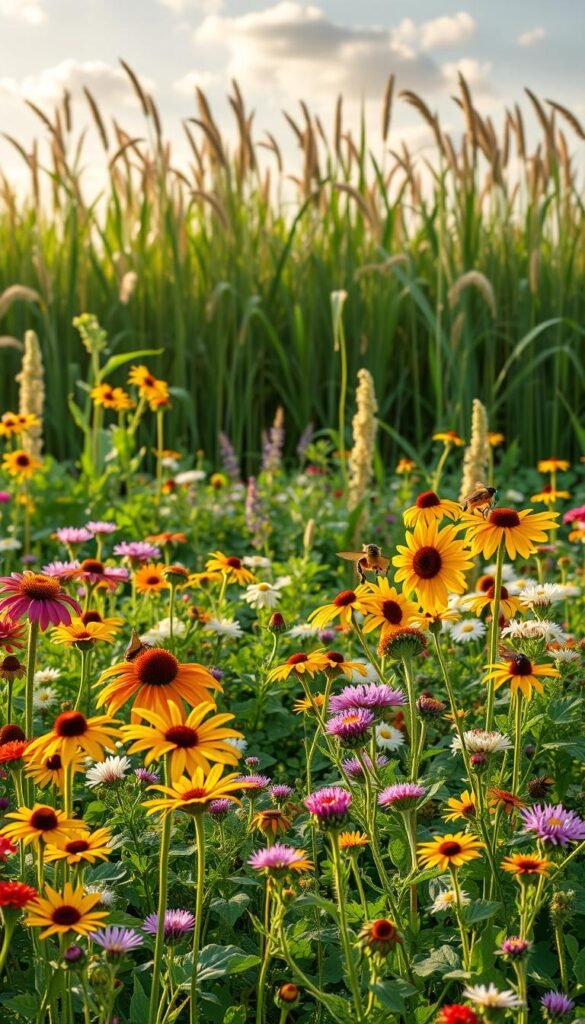
Your garden’s plant selection directly impacts local pollinator populations’ survival. Focus on species that offer reliable nectar supplies and habitat features tailored to your region’s wildlife. This approach builds ecological bridges in urban and suburban areas.
Curating Regional Blooms for Year-Round Buffets
Start by identifying native wildflowers like milkweed or goldenrod using your zip code in the National Wildlife Federation’s database. These species evolved alongside local pollinators, providing ideal nutrition. Aim for three-season blooms:
- Spring: Lupine and columbine
- Summer: Bee balm and coneflower
- Fall: Asters and goldenrod
Group flowers in clusters of three or more. This helps bees spot food sources faster while conserving energy. Avoid double-petaled hybrids – their showy looks often hide poor nectar production.
Seed vs. Nursery Plants: Growth Timelines Explored
Budget and patience determine your best starting point. Compare these options:
| Method | Cost | Time to Bloom |
|---|---|---|
| Seeds | $1-$5 per packet | 6-24 months |
| Nursery Plants | $8-$15 each | 2-8 weeks |
Seeds work well for large meadows but need cold stratification. Nursery plants deliver instant color – place them near seating areas for quick pollinator sightings. Mix both approaches for staggered results.
Remember: Even single flowering pots help. A balcony with native phlox and salvia becomes a mini refueling station for traveling butterflies. Every plant contributes to the larger ecosystem.
Planting Techniques and Preparing Your Garden Beds
Transforming your yard into a thriving pollinator habitat starts with proper groundwork. Healthy soil and strategic planting methods lay the foundation for flowers that buzz with life. Let’s break down the essentials for nurturing robust growth.
Prepping the Soil and Incorporating Compost
Begin by removing existing grass using a sod cutter or smothering technique with cardboard. Loosen compacted earth to 12 inches deep – this gives roots room to spread. Mix in 3 inches of compost to boost nutrients and water retention.
| Soil Amendment | Benefit | Best For |
|---|---|---|
| Worm Castings | Improves drainage | Clay soils |
| Leaf Mold | Retains moisture | Sandy soils |
| Biochar | Locks in nutrients | All soil types |
Test your soil’s pH using a $7 kit from garden centers. Most native flowers thrive in slightly acidic conditions (6.0-6.5). Adjust with lime or sulfur if needed.
Planting Methods: Mulching, Spacing, and Seasonal Tips
Time your seed sowing with nature’s calendar. Fall planting allows cold stratification, while winter sowing on snow lets meltwater bury seeds perfectly. For beginner-friendly flowers, use nursery plants in spring after frost dates pass.
| Plant Type | Spacing | Mulch Depth |
|---|---|---|
| Perennials | 18-24″ | 2-3″ |
| Annuals | 12-18″ | 1-2″ |
| Groundcovers | 6-8″ | None |
Leave some bare ground between plants for solitary bees. Use straw mulch around new transplants to conserve moisture without smothering stems. Remember – overcrowding stresses plants, while too much space wastes pollinator energy.
Special Considerations for Attracting Diverse Pollinators
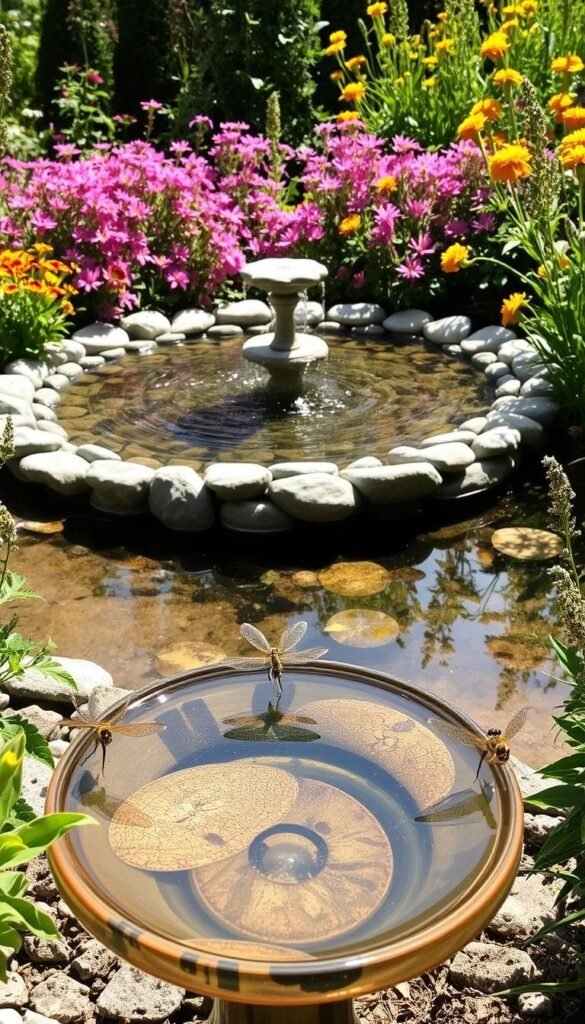
Pollinators need more than colorful blooms to thrive. By adding strategic features and plant varieties, you create a complete habitat supporting bees, butterflies, and hummingbirds throughout their life cycles.
Creating Water Features and Nesting Areas
Shallow water sources keep pollinators hydrated without drowning risks. Try these options:
| Feature | Components | Benefit |
|---|---|---|
| Butterfly Puddler | Sand + sea salt + water | Provides egg-development minerals |
| Bee Watering Station | Marbles in shallow dish | Safe landing spots |
| Hummingbird Mister | Dripping water near flowers | Attracts aerial feeders |
Refresh water every 48 hours to prevent mosquitoes. Leave bare ground patches near shrubs for 70% of native bees that nest underground. Avoid thick mulch layers – they block access to soil tunnels.
Supporting Bees, Butterflies, and Hummingbirds Through Plant Choices
Different pollinators seek specific pollen sources and structures:
| Plant Type | Attracts | Key Feature |
|---|---|---|
| Tube-shaped blooms | Hummingbirds | Deep nectar reserves |
| Flat clusters | Butterflies | Landing platforms |
| Small flowers | Bees | Accessible pollen |
Include shrubs like buttonbush for vertical diversity. Plant milkweed for monarch caterpillars and fuchsia for hummingbirds. Layer plants in heights from groundcovers to 6-foot blooms – this creates microhabitats for various species.
DIY Projects and Container Garden Ideas for Small Spaces
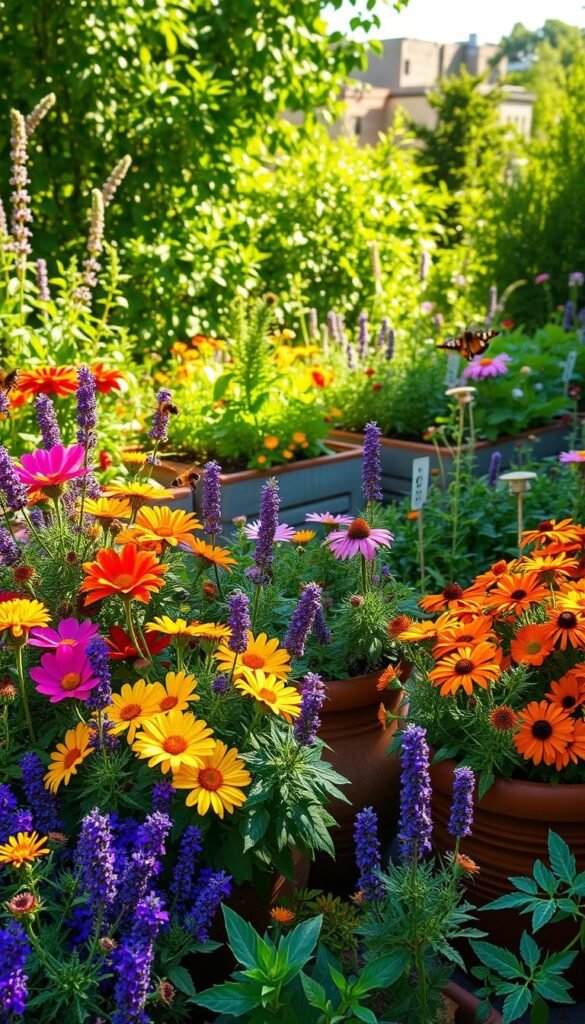
Limited square footage doesn’t mean limited impact. Urban balconies and tiny patios can burst with life when you embrace creative growing options. A single well-planned container feeds pollinators while adding beauty to your concrete jungle view.
Designing Attractive Container Gardens for Pollinators
Start with drainage holes and lightweight pots – terra cotta dries out too fast. Use a 70/30 mix of potting soil and compost. This combo retains moisture while letting roots breathe. Match plants with similar needs:
| Target Pollinator | Plant Trio | Care Tips |
|---|---|---|
| Butterflies | Parsley + Zinnias + Lavender | Full sun, water every 2 days |
| Bees | Salvia + Marigolds + Thyme | Morning sun, let soil dry slightly |
| Hummingbirds | Fuchsia + Nasturtium + Bee Balm | Partial shade, daily watering |
Rotate colorful annuals seasonally. Pansies work in spring, while autumn sedum keeps blooms coming. Group 3-5 pots together – clusters attract more winged visitors.
Creative Solutions for Apartments and Limited-Yard Environments
Go vertical with hanging baskets of trailing lantana or stackable planters. Repurpose old colanders into strawberry planters – bees adore their white flowers. Try these space-smart ideas:
| Space Type | Solution | Pollinator Benefit |
|---|---|---|
| Fire escapes | Rail planters with milkweed | Monarch waystation |
| Window sills | Herb garden in mason jars | Bee feeding station |
| Walls | Pocket planters with sedum | Butterfly landing pads |
Use rolling carts for movable gardens – perfect for renters. A 2’x2’ cart holds 9 plants! Water deeply in the morning to reduce evaporation. Remember: Even a windowsill basil plant helps pollinators while spicing up your meals.
Bringing Your Pollinator Garden Vision to Life
Your journey from concept to buzzing habitat starts with simple steps. Even a single pot of native flowers makes a difference. Focus on progress, not perfection – pollinators appreciate every bloom you provide.
Pair vibrant perennials with seasonal annuals for continuous color. Include pollinator garden staples like milkweed and coneflower, but don’t forget herbs like basil or oregano. These dual-purpose plants feed both insects and your kitchen.
Small spaces shine through creative solutions. Try container gardening flowers that attract pollinators on patios or windowsills. Group pots by bloom time to maintain nectar flow. Watch bees visit within days of planting!
Leave some leaf litter and bare soil for nesting. Avoid pesticides – even organic sprays can harm delicate larvae. Share extra plants with neighbors to expand safe zones across your community.
Your garden becomes part of a vital network supporting food systems and biodiversity. Grab your gloves, pick up a trowel, and witness nature’s magic unfold. Those fluttering wings and buzzing visitors? They’re proof you’ve created life-sustaining beauty.

